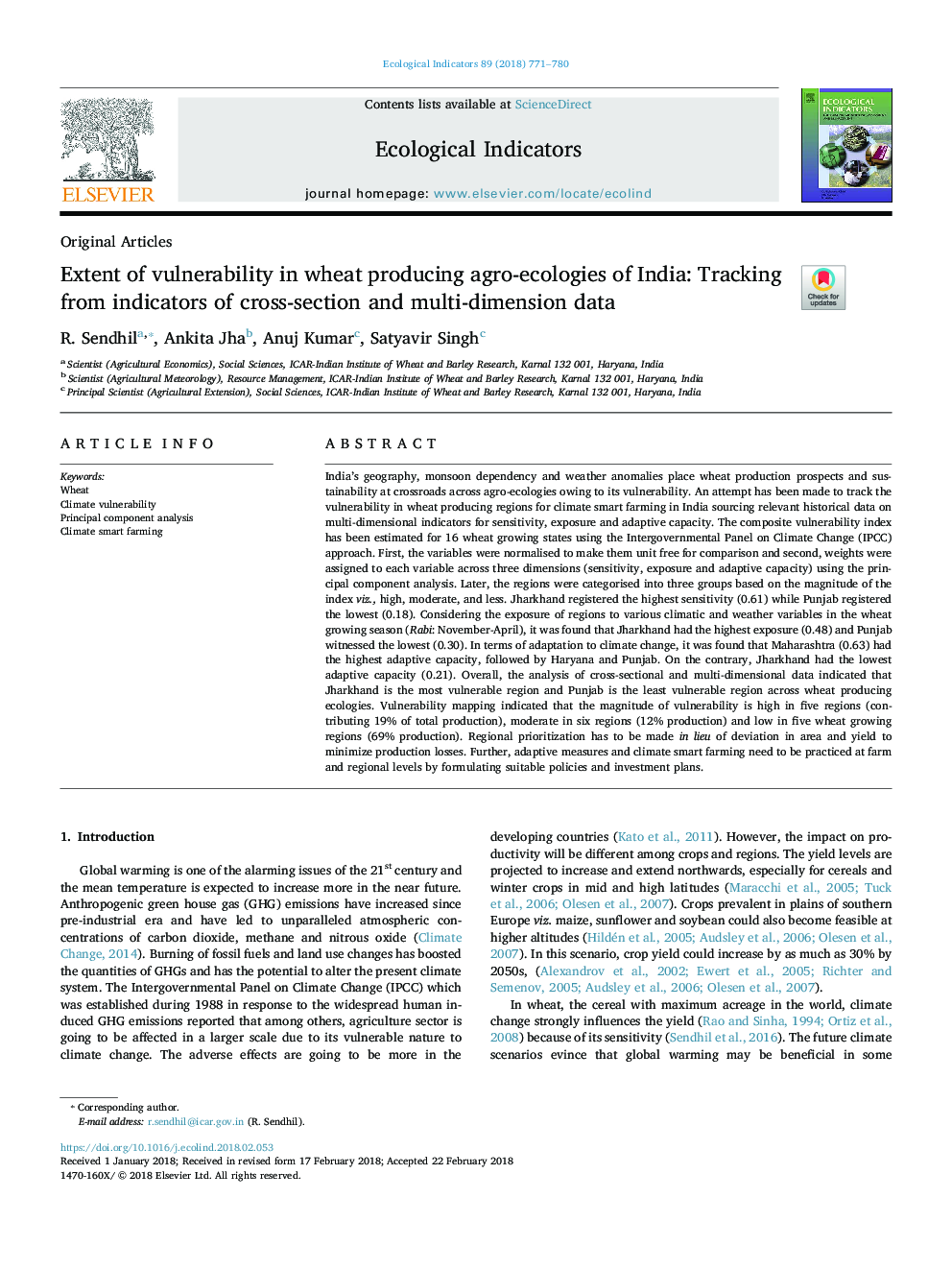| کد مقاله | کد نشریه | سال انتشار | مقاله انگلیسی | نسخه تمام متن |
|---|---|---|---|---|
| 8845528 | 1617113 | 2018 | 10 صفحه PDF | دانلود رایگان |
عنوان انگلیسی مقاله ISI
Extent of vulnerability in wheat producing agro-ecologies of India: Tracking from indicators of cross-section and multi-dimension data
ترجمه فارسی عنوان
میزان آسیب پذیری در گندم کشاورزی زیست محیطی هند: ردیابی از شاخص های مقطعی و چند بعدی
دانلود مقاله + سفارش ترجمه
دانلود مقاله ISI انگلیسی
رایگان برای ایرانیان
کلمات کلیدی
گندم، آسیب پذیری هوا، تجزیه و تحلیل مولفه اصلی، آب و هوای کشاورزی هوشمند،
موضوعات مرتبط
علوم زیستی و بیوفناوری
علوم کشاورزی و بیولوژیک
بوم شناسی، تکامل، رفتار و سامانه شناسی
چکیده انگلیسی
India's geography, monsoon dependency and weather anomalies place wheat production prospects and sustainability at crossroads across agro-ecologies owing to its vulnerability. An attempt has been made to track the vulnerability in wheat producing regions for climate smart farming in India sourcing relevant historical data on multi-dimensional indicators for sensitivity, exposure and adaptive capacity. The composite vulnerability index has been estimated for 16 wheat growing states using the Intergovernmental Panel on Climate Change (IPCC) approach. First, the variables were normalised to make them unit free for comparison and second, weights were assigned to each variable across three dimensions (sensitivity, exposure and adaptive capacity) using the principal component analysis. Later, the regions were categorised into three groups based on the magnitude of the index viz., high, moderate, and less. Jharkhand registered the highest sensitivity (0.61) while Punjab registered the lowest (0.18). Considering the exposure of regions to various climatic and weather variables in the wheat growing season (Rabi: November-April), it was found that Jharkhand had the highest exposure (0.48) and Punjab witnessed the lowest (0.30). In terms of adaptation to climate change, it was found that Maharashtra (0.63) had the highest adaptive capacity, followed by Haryana and Punjab. On the contrary, Jharkhand had the lowest adaptive capacity (0.21). Overall, the analysis of cross-sectional and multi-dimensional data indicated that Jharkhand is the most vulnerable region and Punjab is the least vulnerable region across wheat producing ecologies. Vulnerability mapping indicated that the magnitude of vulnerability is high in five regions (contributing 19% of total production), moderate in six regions (12% production) and low in five wheat growing regions (69% production). Regional prioritization has to be made in lieu of deviation in area and yield to minimize production losses. Further, adaptive measures and climate smart farming need to be practiced at farm and regional levels by formulating suitable policies and investment plans.
ناشر
Database: Elsevier - ScienceDirect (ساینس دایرکت)
Journal: Ecological Indicators - Volume 89, June 2018, Pages 771-780
Journal: Ecological Indicators - Volume 89, June 2018, Pages 771-780
نویسندگان
R. Sendhil, Ankita Jha, Anuj Kumar, Satyavir Singh,
